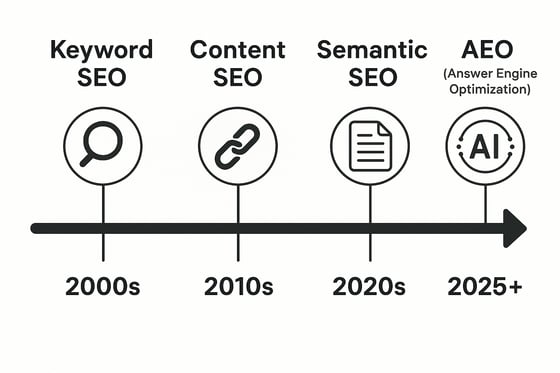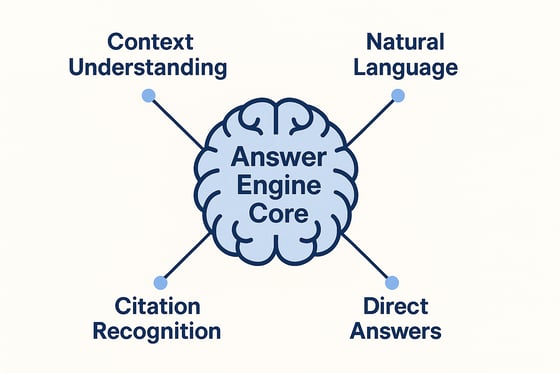The Digital Marketing Quake: From SEO to the Dawn of AEO
Is SEO Dead? The Truth Behind the Hype

What is AEO? Decoding the New Language of Search

The Core Principles of AEO: A New Rulebook for Content
- Conversational Clarity: AI search engines excel at understanding natural language. Content that is written in a clear, concise, and conversational tone is favored because it mirrors how users ask questions. Think less about keyword density and more about answering questions directly and comprehensively, almost as if you’re speaking to someone. This natural language processing allows AI models to better grasp the nuance and intent behind queries.
- Long-Form but Structured Content: While AI can process vast amounts of information, it needs structure to extract key insights efficiently. Long-form content allows for comprehensive coverage of a topic, but it must be well-organized with clear headings, subheadings, bullet points, and concise summaries. This structure aids AI tools in quickly identifying and synthesizing relevant information, improving accessibility for AI retrieval. Think of it as making your content "AI-readable."
- User Intent Alignment: Beyond keywords, AEO demands a deep understanding of the user's underlying intent. Why are they searching? What problem are they trying to solve? Content must be designed to directly address this broader intent, providing relevant and useful answers. This means moving beyond simple keyword matching and focusing on the semantic meaning and context of queries.
The Impact: Why Traditional Search is Declining
- Reduced Click-Through Rates (CTR): If AI provides the answer directly, fewer users will click on organic listings.
- Shift in Discoverability: Simply ranking on Google's first page is no longer enough. Your content needs to be discoverable by AI models.
- Emphasis on Direct Answers: Your content must be structured to provide immediate value and direct answers to common questions.
As marketers, we must reassess their organic search strategies, focusing on AI-driven discoverability rather than just keyword-based rankings.
Despite the initial fears of traffic loss, recent data paints a compelling picture of AI's growing influence on web traffic and conversions. According to a 2025 Previsible AI Traffic Report, total AI-referred sessions jumped by an astonishing 527% between January and May 2025 compared to the same period in 2024, across 19 GA4 properties.
Furthermore, AI-driven traffic is proving to be incredibly valuable. An analysis of 12 million website visits found that AI search traffic converts at 14.2% compared to Google's 2.8%—a remarkable 5x difference.
This uptrend isn't uniform across all industries, but high-consultative sectors are leading the charge. Legal, Finance, SMB, Insurance, and Health collectively accounted for 55% of all LLM-driven sessions, indicating that users are turning to AI for complex, contextual questions. This suggests that AI platforms like ChatGPT, Perplexity, Claude, and Gemini are rapidly becoming a "front door to commerce", revolutionizing the customer journey.
This trend is particularly explosive in sectors that blend inspiration with practical advice, which directly mirrors our own experience. For one of our clients in the Home & Garden category in the US, we’ve seen a tangible increase in both high-quality traffic and conversions originating from AI platforms. This isn't an isolated case. A recent report from Similarweb provides a stunning validation of this trend.

The Similarweb data from July 2023 to June 2025 shows that GenAI referrals to Home & Garden websites in the US have skyrocketed by an incredible +5723% year-over-year.
This surge is happening even as overall site visits in the category see a decline, positioning AI as a crucial channel for growth. The data reveals that major players like Home Depot and Lowe's are receiving millions of AI referrals, accounting for 36% and 20% of the volume, respectively. This proves that AI tools are already a massive force in influencing shopper discovery for everything from home décor to major DIY projects.
While the overall volume of traffic from AI sources might still be smaller than traditional search for many businesses (AI-driven search traffic represents less than 1% of total traffic for most websites), the quality and conversion potential of this traffic are undeniable. This reinforces our observation that the fundamental need for high-quality, valuable content remains paramount, even as the mechanisms of discovery evolve.
The New Gatekeepers: Key Players in AI Search
- ChatGPT (OpenAI): Known for its conversational AI, ChatGPT's responses are based on its training data up to a certain cutoff. Optimizing for ChatGPT means creating up-to-date, easily digestible content that directly addresses common search inquiries.
- Gemini (Google AIOs): As an integral part of Google Search, Gemini heavily influences search results through AI Overviews. Brands should align their content with Google's preference for factual, structured, and high-quality information to appear in these overviews.
- Perplexity: This AI model prioritizes cited sources, often displaying a mix of authoritative and user-generated content. To gain visibility here, focus on being referenced in well-cited, high-authority sources and actively participating in discussions where citations are common.
- Claude (Anthropic): With an emphasis on safe and ethical AI responses, Claude favors educational, well-structured content that adheres to responsible AI principles.

AI Penetration Rate by Industry (Source: Search Engine Land)
AI Penetration Rate by Industry:
Embracing the Future: Your Path Forward
The AI search revolution is here, and it's transforming how brands connect with their audience. While it presents challenges, it also offers immense opportunities for those willing to adapt. For us seasoned digital marketers, this is a chance to leverage our deep understanding of user behavior and content strategy in a powerful new way.
The core takeaway from our reverse engineering efforts is clear: the fundamental need for high-quality, valuable, and trustworthy content has never been stronger. This is why our previous efforts on creating excellent content were never wasted. However, to truly stand out, we need to act swiftly to make our content not just friendly to humans, but also highly optimized for AI consumption.
The shift to AEO isn't about abandoning SEO entirely; it's about evolving it. It's about combining the best of traditional practices with a forward-thinking, AI-centric approach. My next posts will delve into how to conduct advanced competitor research in this new landscape, and then provide practical, actionable steps to optimize your content for AEO success.
Are you ready to embrace this change and lead your clients into the future of search? The time to start optimizing for AI is now.
